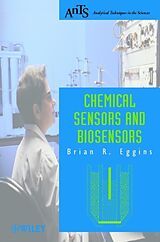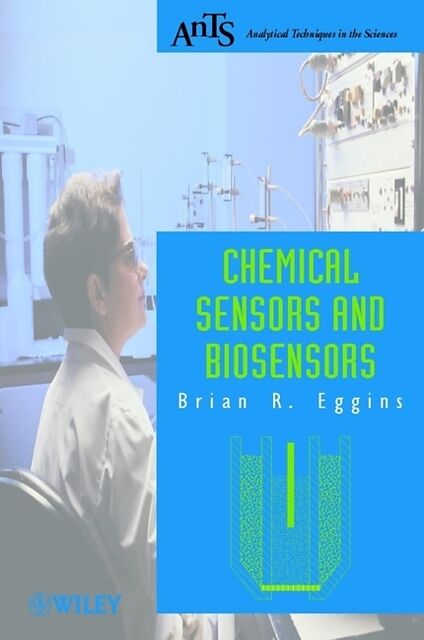Chemical Sensors and Biosensors
Einband:
Kartonierter Einband
EAN:
9780471899143
Untertitel:
AnTS, Analytical Techniques in the Sciences
Genre:
Chemie
Autor:
Brian R Eggins
Herausgeber:
Wiley
Auflage:
2. Aufl.
Anzahl Seiten:
300
Erscheinungsdatum:
26.04.2002
ISBN:
978-0-471-89914-3
In the last ten years there have been huge devleopments in sensor technology; however, the supply of authoritative textbooks on the subject has not been equal to the demand created by the increasing number of undergraduate and graduate courses on sensors in analytic chemistry programs. This book, accessible to a broad audience, covers the latest advances in sensor technology.
Informationen zum Autor Brian R. Eggins is the author of Chemical Sensors and Biosensors, published by Wiley. Klappentext Chemical sensors and biosensors are among the fastest growing of analytical techniques. This text provides an up-to-the-minute overview of a wide range of sensing systems, discussing the elements of different transducers used in sensors and the selective elements that are employed. The style is relatively non-mathematical and informal in approach.Key features and subjects covered include the following:* Sensors based on both electrochemical and photometric transducers* Mass-sensitive sensors* Thermal-sensitive sensors* Performance factors for sensors* Examples of applications* Detailed case studies of five selected sensors* 30 discussion questions with worked examples and 80 self-assessment questions* 140 explanatory diagrams* An extensive bibliographyThe book's approach is ideal for students at BTEC (HND and HNC) level, as well as for BSc degree and postgraduate students of analytical and physical chemistry. Chemical Sensors and Biosensors will, in addition, be invaluable to all those concerned with the environmental and biomedical applications of such systems Zusammenfassung Covering the developments in sensor technology and electronic sensing devices, this book provides aid for those wishing to use chemical and biosensors. It covers key features and subjects that include: sensors based on both electrochemical and photometric transducers; mass-sensitive sensors; thermal-sensitive sensors; and more. Inhaltsverzeichnis Series PrefaceAuthor's PrefaceAcronyms, Abbreviation and SymbolsAbout the AuthorIntroductionIntroduction to sensorsSensors and biosensors - definitionsAspects of sensorsTransduction ElementsElectrochemical transducers - introductionPotentiometry and ion selective electrodes: the Nernst equationVoltammetry and amperometryConductivityField effect transistorsModified electrodes, thin film electrodes, microelectrodes and screen printed electrodesPhotometric sensorsSensing ElementsIntroductionIonic recognitionMolecular recognition - chemical recognition agentsMolecular recognition - spectroscopic recognitionMolecular recognition - biological recognition agentsImmobilisation of biological componentPerformance FactorsIntroductionSelectivitySensitivityTime factorsPrecision, accuracy and repeatabilityDifferent biomaterialsDifferent transducersSome factors affecting the performance of sensorsElectrochemical Sensors and BiosensorsPotentiometric sensors - ion selective electrodesPotentiometric biosensorsAmperometric sensorsConductometric sensors and biosensorsApplications of FET sensorsPhotometric ApplicationsTechniques for optical sensorsVisible absorption spectroscopyFluorescent reagentsIndirect methods using competitive bindingReflection methodsLight scattering techniquesMass Sensitive and Thermal SensorsThe piezo-electric effectSurface acoustic wavesThermal sensorsSome Specific ApplicationsDetermination of glucose in blood - amperometric biosensorDetermination of ng levels of copper (I) in water using anodic stripping voltammetry using an electrode modified with a complexing agentDetermination of several ions simultaneously - "the laboratory on a chip"Determination of ato-mole levels of trinitrotoluene (TNT) - antibody with a luminescent transducerDetermination of flavanols in beers...
Autorentext
Brian R. Eggins is the author of Chemical Sensors and Biosensors, published by Wiley.
Klappentext
Chemical sensors and biosensors are among the fastest growing of analytical techniques. This text provides an up-to-the-minute overview of a wide range of sensing systems, discussing the elements of different transducers used in sensors and the selective elements that are employed. The style is relatively non-mathematical and informal in approach. Key features and subjects covered include the following: * Sensors based on both electrochemical and photometric transducers * Mass-sensitive sensors * Thermal-sensitive sensors * Performance factors for sensors * Examples of applications * Detailed case studies of five selected sensors * 30 discussion questions with worked examples and 80 self-assessment questions * 140 explanatory diagrams * An extensive bibliography The book's approach is ideal for students at BTEC (HND and HNC) level, as well as for BSc degree and postgraduate students of analytical and physical chemistry. Chemical Sensors and Biosensors will, in addition, be invaluable to all those concerned with the environmental and biomedical applications of such systems
Zusammenfassung
Covering the developments in sensor technology and electronic sensing devices, this book provides aid for those wishing to use chemical and biosensors. It covers key features and subjects that include: sensors based on both electrochemical and photometric transducers; mass-sensitive sensors; thermal-sensitive sensors; and more.
Inhalt
Series Preface Author's Preface Acronyms, Abbreviation and Symbols About the Author Introduction Introduction to sensors Sensors and biosensors - definitions Aspects of sensors Transduction Elements Electrochemical transducers - introduction Potentiometry and ion selective electrodes: the Nernst equation Voltammetry and amperometry Conductivity Field effect transistors Modified electrodes, thin film electrodes, microelectrodes and screen printed electrodes Photometric sensors Sensing Elements Introduction Ionic recognition Molecular recognition - chemical recognition agents Molecular recognition - spectroscopic recognition Molecular recognition - biological recognition agents Immobilisation of biological component Performance Factors Introduction Selectivity Sensitivity Time factors Precision, accuracy and repeatability Different biomaterials Different transducers Some factors affecting the performance of sensors Electrochemical Sensors and Biosensors Potentiometric sensors - ion selective electrodes Potentiometric biosensors Amperometric sensors Conductometric sensors and biosensors Applications of FET sensors Photometric Applications Techniques for optical sensors Visible absorption spectroscopy Fluorescent reagents Indirect methods using competitive binding Reflection methods Light scattering techniques Mass Sensitive and Thermal Sensors The piezo-electric effect Surface acoustic waves Thermal sensors Some Specific Applications Determination of glucose in blood - amperometric biosensor Determination of ng levels of copper (I) in water using anodic stripping voltammetry using an electrode modified with a complexing agent Determination of several ions simultaneously - "the laboratory on a chip" Determination of ato-mole levels of trinitrotoluene (TNT) - antibody with a luminescent transducer Determination of flavanols in beers

Leider konnten wir für diesen Artikel keine Preise ermitteln ...
billigbuch.ch sucht jetzt für Sie die besten Angebote ...
Die aktuellen Verkaufspreise von 5 Onlineshops werden in Realtime abgefragt.
Sie können das gewünschte Produkt anschliessend direkt beim Anbieter Ihrer Wahl bestellen.
Loading...
Die aktuellen Verkaufspreise von 5 Onlineshops werden in Realtime abgefragt.
Sie können das gewünschte Produkt anschliessend direkt beim Anbieter Ihrer Wahl bestellen.
| # | Onlineshop | Preis CHF | Versand CHF | Total CHF | ||
|---|---|---|---|---|---|---|
| 1 | Seller | 0.00 | 0.00 | 0.00 |
